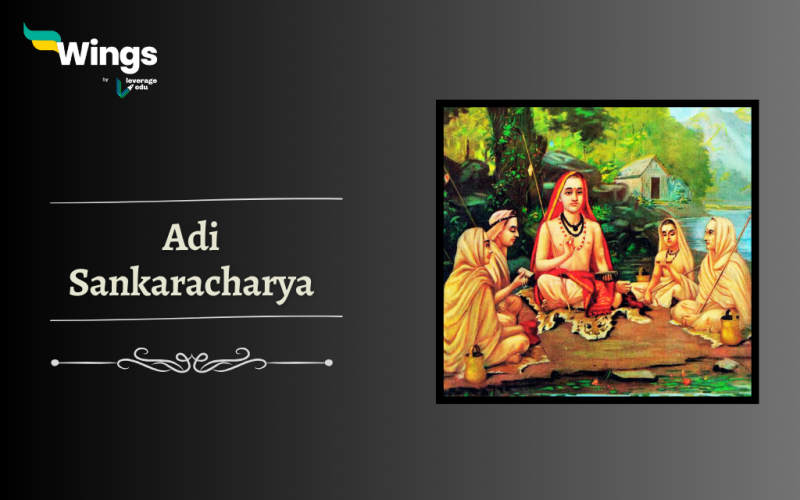Adi Shankaracharya is also known as Shankara Bhagavatpada. He was a revered Indian philosopher and theologian who lived in the 8th century CE. Regarded as the greatest exponent of Advaita Vedanta Philosophy and was the head of the Sringeri Sharada Peeth. This article delves into the early life, great works and significant contributions of Adi Shankaracharya to the world of spirituality and philosophy.
Table of Contents
Who was Adi Shankaracharya?
Adi Shankaracharya was born in the southern Indian state of Kerala in the year 788 CE.
- From a young age, he exhibited remarkable intellectual abilities and immense spiritual inclination.
- He undertook rigorous studies and became a master of various Vedic texts, Upanishads, and other philosophical treatises.
- Shankaracharya’s sharp intellect and devotion led him to embark on a transformative spiritual journey.
- Guru Govindhabhagavath Pada was the teacher of Adi Shankarayacharya.
Also Read – Saint Ramanujacharya: Life, Philosophy, Works
Great Works of Ai Shankarayacharya
Adi Shankaracharya integrated some of the essences of Buddhism into the Hindu thought process and accordingly interpreted the ancient Vedic religion.
1. Commentaries on the Prasthanatraya
- Adi Shankaracharya is renowned for his commentaries on the Prasthanatraya, which consists of the Upanishads, the Bhagavad Gita and the Brahma Sutras.
- His commentaries provide various insights and interpretations, unravelling the deeper meanings of these sacred texts.
- These works are considered essential for understanding Advaita Vedanta, emphasizing the non-dualistic nature of reality.
Fun Fact – Brhat-Sankara-Vijaya by Citsukha is the oldest biography of Adi Shankaracharya
2. Advaita Vedanta Philosophy (Non-Dualism)
- Shankaracharya’s most significant contribution is the development and propagation of Advaita Vedanta philosophy.
- Advaita Vedanta asserts the ultimate reality as Brahman, the unchanging and all-pervading existence that transcends the material world.
- Ge believed that God and the created world are one and that the individual soul is not different from the ultimate reality i.e. Brahman.
- In his renowned work, “Brahma Sutras Bhashya,” Shankaracharya provides a comprehensive interpretation of the Brahma Sutras, outlining the principles of Advaita Vedanta.
- Shankaracharya emphasized the concept of “Brahman” as the supreme reality, which is beyond attributes, form, and time.
- He explained that the individual self, known as “Atman,” is identical to the eternal, infinite Brahman and realizing this unity leads to spiritual liberation.
- Shankaracharya expounded on the concept of Maya, the illusion that veils our true nature and stressed the importance of self-realization to overcome this illusion.
Also Read – Who was Chaitanya Mahaprabhu?
3. Establishment of Four Mathas
- Adi Shankaracharya established four Mathas/Mutts (monastic institutions) in different regions of India: 1. Sri Sringeri Sharada Peetha (in the South), Kalika Matha in Dwaraka (in the West), Govardhana Matha in Puri (in the East), and Jyotir Matha in Joshimath (in the North).
- These mathas continue to act as centres of spiritual learning, preserving and disseminating Shankaracharya’s teachings.
- The heads of these mathas, known as Shankaracharyas, are regarded as the successors of Adi Shankaracharya.
4. Revitalization of Hinduism
- During his time, Hinduism faced challenges and was overshadowed by ritualistic practices and dogmas.
- He believed one can attain Moksha after getting the knowledge of the Vedas.
- Adi Shankaracharya played a pivotal role in revitalizing Hinduism, purifying religious practices and reinstating the supremacy of Vedantic philosophy.
- H was the organizer of the Dashanami Monastic order and unified the Shanmata tradition of worship.
- He implemented reforms, revived Vedic rituals and established ashrams to promote spiritual growth and knowledge.
Also Read – Goswami Tulsidas: Life, Works and Ramacharitmanas
Contribution of Adi Shankaracharya
Adi Shankaracharya’s contributions are not limited to the realm of philosophy and spirituality. He left his mark as a revered religious man. Some of his great work includes –
- Undertaking extensive journeys across the Indian subcontinent to restore the prominence of ancient Hindu scriptures and philosophical texts.
- He has authored nearly 116 books which also includes the commentaries.
- He composed commentaries on the major Upanishads, such as the “Mandukya Upanishad,” “Katha Upanishad,” and “Chandogya Upanishad,” providing insights into their deep spiritual meanings.
- Shankaracharya also wrote commentaries on the major Hindu scriptures, including the Bhagavad Gita, the Brahma Sutras, and the ten principal Upanishads.
- His commentaries played a crucial role in preserving and promoting the teachings of these texts, ensuring their continued relevance and understanding.
- Shankaracharya’s influence was instrumental in shaping the bhakti (devotional) movement and the subsequent development of Hindu thought.
- He also emphasized the importance of temple worship as a means to connect with the divine and rejuvenate spiritual fervour among the masses.
- His efforts helped restore the significance and grandeur of temples and ensured their continued reverence and cultural importance.
Fun Fact – In Omkareshwar, a 108 feet tall statue of Adi Shankaracharya is known as the “Statue of Oneness”

Adi Shankaracharya’s contributions to Hindu philosophy, spirituality, and culture remain timeless and invaluable. His teachings and works continue to guide seekers on the path of self-realization and spiritual enlightenment. Through his revitalization of Advaita Vedanta and his establishment of mathas, Shankaracharya ensured the preservation and propagation of Hinduism’s core principles.
Shankara Jayanti
The birthday of Sri Adi Shankaracharya is celebrated as Shankara Jayanthi. He is regarded as an embodiment of Lord Shiva and the most esteemed Guru (Jagad Guru). He refined the Vedas by imparting discrimination and established the adoration of Deities as the worship of diverse forms of the One God.
It is said in Hindu scriptures that when people began to lose their sense of purity and spirituality, all the gods and goddesses approached Lord Shiva for help in saving the world. Lord Shiva promised to be born as Adi Shankaracharya and encouraged people towards spirituality for the salvation of all living beings. As promised, Lord Shiva was born on earth as Adi Shankaracharya and spread the importance of the Hindu religion to the people. Therefore, the birth anniversary of Adi Shankaracharya is celebrated with great enthusiasm in Hinduism culture.
Relevant Blogs
That’s all about Adi Shankaracharya! If you want to know more about topics like this, then visit our general knowledge page! Alternatively, you can also read our blog on general knowledge for competitive exams!
 One app for all your study abroad needs
One app for all your study abroad needs













